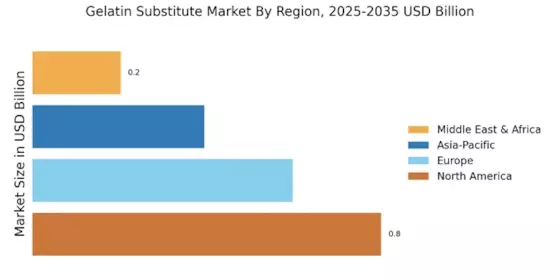The Gelatin Substitute Market is currently characterized by a dynamic competitive landscape, driven by increasing consumer demand for plant-based alternatives and a growing awareness of dietary restrictions. Key players such as Gelita AG (Germany), Rousselot (Netherlands), and Kerry Group (Ireland) are strategically positioning themselves to capitalize on these trends. Gelita AG (Germany) focuses on innovation in product development, particularly in plant-based gelatin substitutes, which aligns with the rising trend of veganism. Rousselot (Netherlands) emphasizes sustainability in its operations, aiming to reduce its carbon footprint while expanding its product offerings. Meanwhile, Kerry Group (Ireland) is leveraging its extensive distribution network to enhance market penetration, particularly in emerging markets. Collectively, these strategies indicate a shift towards sustainability and innovation, shaping a competitive environment that prioritizes consumer preferences.
In terms of business tactics, companies are increasingly localizing manufacturing to reduce supply chain vulnerabilities and optimize logistics. The Gelatin Substitute Market appears moderately fragmented, with several players vying for market share. However, the influence of major companies is significant, as they set trends and standards that smaller firms often follow. This competitive structure allows for a diverse range of products, catering to various consumer needs while fostering innovation across the sector.
In August 2025, Gelita AG (Germany) announced the launch of a new line of plant-based gelatin alternatives, which is expected to cater to the growing vegan market. This strategic move not only enhances Gelita's product portfolio but also positions the company as a leader in the plant-based segment, potentially attracting a broader customer base. The introduction of these alternatives reflects a proactive approach to meet changing consumer preferences and regulatory pressures regarding animal-derived products.
In September 2025, Rousselot (Netherlands) unveiled its commitment to achieving carbon neutrality by 2030, a significant step towards sustainability in the gelatin substitute sector. This initiative is likely to resonate with environmentally conscious consumers and businesses, enhancing Rousselot's brand reputation and market appeal. By prioritizing sustainability, Rousselot not only addresses consumer demands but also aligns with global sustainability goals, potentially influencing industry standards.
In July 2025, Kerry Group (Ireland) expanded its partnership with a leading plant-based food manufacturer to co-develop innovative gelatin substitutes. This collaboration is indicative of Kerry's strategy to enhance its product offerings through strategic alliances, which may lead to the development of unique formulations that cater to specific dietary needs. Such partnerships are crucial in a market where innovation is key to maintaining competitive advantage.
As of October 2025, the Gelatin Substitute Market is witnessing trends that emphasize digitalization, sustainability, and the integration of artificial intelligence in product development and supply chain management. Strategic alliances are increasingly shaping the competitive landscape, allowing companies to pool resources and expertise to drive innovation. Looking ahead, competitive differentiation is likely to evolve from traditional price-based competition to a focus on technological advancements, sustainable practices, and reliable supply chains, reflecting the changing priorities of consumers and regulatory bodies.


















Leave a Comment